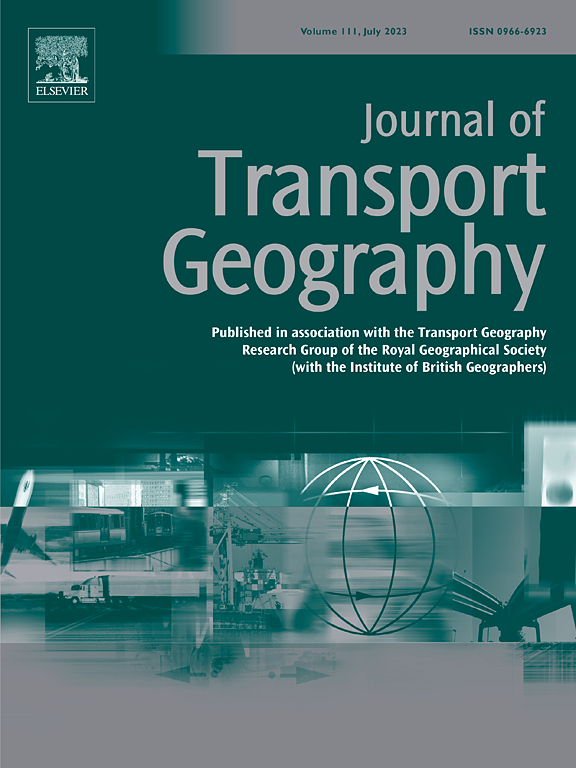Spatial-temporal insights into gender gaps in East Asian ride-hailing: Workload, efficiency, nighttime safety, and operational patterns
IF 5.7
2区 工程技术
Q1 ECONOMICS
引用次数: 0
Abstract
This study investigates gender differences in the operational strategies of ride-hailing drivers in Suzhou, China, using identity-confirmed trip data from October 2023. Four novel operational metrics (workload, earning capacity, operational efficiency, and willingness to work far from home) were developed to quantify gender-based operational preferences between male drivers and female drivers, who were further divided into age groups. The Geographically Weighted Random Forest (GWRF) model was applied to examine spatial correlations with socioeconomic and built environment factors in order to understand the spatial and temporal preferences of the drivers. Statistics reveal only 5 % of the drivers are female and within that fewer (5 %) are young female drivers. Spatial-temporal analysis indicated that female drivers generally work shorter distances, earn less, and prioritize trips closer to home, which may be influenced by family caregiving responsibilities, but exhibit similar operational efficiency (indicated by revenue per hour) as male drivers under comparable demand conditions. Age gaps are further observed among female drivers: senior female drivers worked significantly longer during holidays but avoided nighttime operations similarly to younger females, reflecting the former group's heavier financial burdens related to family responsibilities and shared safety concerns with the latter. The results of GWRF show little impact of street safety on daytime pick-up locations across genders which is different than Western contexts. However, nighttime spatial preferences significantly differ among younger female drivers compared to older and male drivers, reflecting higher safety concerns. These insights inform platform operators to prioritize order allocation near female drivers' residences and improve safety measures, thereby supporting gender equity and inclusivity at a government level.
东亚网约车行业性别差距的时空洞察:工作量、效率、夜间安全和运营模式
本研究利用2023年10月以来的身份确认出行数据,调查了中国苏州网约车司机运营策略的性别差异。研究人员开发了四个新的运营指标(工作量、收入能力、运营效率和远离家乡工作的意愿),以量化男性司机和女性司机之间基于性别的运营偏好,并将其进一步划分为年龄组。采用地理加权随机森林(GWRF)模型,分析了驾驶员的时空偏好与社会经济因素和建筑环境因素的空间相关性。统计数据显示,只有5%的司机是女性,其中年轻女司机的比例更低(5%)。时空分析表明,女性司机通常工作距离较短,收入较低,并且优先考虑离家较近的行程,这可能受到家庭照顾责任的影响,但在可比需求条件下,与男性司机表现出相似的运营效率(以每小时收入表示)。在女司机中,年龄差距也进一步显现出来:年长的女司机在假期工作的时间明显更长,但与年轻的女司机一样,她们避免夜间作业,这反映出前者在家庭责任方面的经济负担更重,而且与后者有共同的安全担忧。GWRF的结果显示,不同性别的街道安全对白天接送地点的影响不大,这与西方环境不同。然而,与老年司机和男性司机相比,年轻女性司机对夜间空间的偏好存在显著差异,反映出更高的安全担忧。这些见解使平台运营商能够优先考虑在女性司机住所附近分配订单,并改进安全措施,从而支持政府层面的性别平等和包容性。
本文章由计算机程序翻译,如有差异,请以英文原文为准。
求助全文
约1分钟内获得全文
求助全文
来源期刊

Journal of Transport Geography
Multiple-
CiteScore
11.50
自引率
11.50%
发文量
197
期刊介绍:
A major resurgence has occurred in transport geography in the wake of political and policy changes, huge transport infrastructure projects and responses to urban traffic congestion. The Journal of Transport Geography provides a central focus for developments in this rapidly expanding sub-discipline.
 求助内容:
求助内容: 应助结果提醒方式:
应助结果提醒方式:


